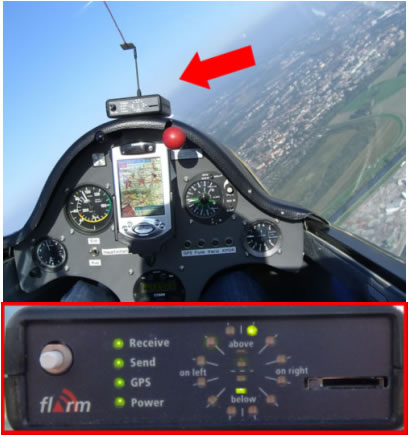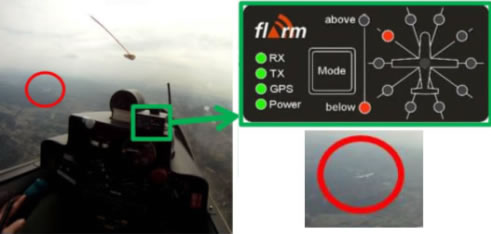ONERA has patented the principle of a low-cost device that significantly secures recreational aviation. The company Flarm Technology GmbH has developed the technology under license from Onera. With GPS data and a radio transceiver, FLARM locates other aircraft, gliders or drones equipped with Flarm flying nearby and offers the pilot a situational awareness that makes it possible to avoid midair collisions or collisions when landing. This system was made mandatory in France for gliders by an FFVV (French Gliding Federation) decision in March 2013.
Flarm became mandatory for gliders in France, as from the 1st of March 2013
This 1st of March 2013, by a decision of the French Gliding Federation (FFVV) (http://www.flarm.com/news/FFVV_CirculaireFlarmEN.pdf) carrying a Flarm became mandatory on all gliders, motor gliders and utility aircraft used in France.

Flarm installed above the dashboard of an ASW19. The enlarged view of the Flarm dial indicates that another glider is in front, flying at a lower altitude, invisible.
This firm decision was taken following the tragic crash on May 5, 2012 between a glider and a tow plane near Paris. Three very experienced pilots were the victims. In France, 48 midair collisions have been recorded since 1988 and 30 glider pilots have lost their lives.
This significant number of accidents is due to the fragility of the "see and avoid" concept. Indeed, in many airspaces, this principle which is the foundation of flight safety, is simply based on the perception by pilots of the air situation around their aircraft. The problem is that it is not always easy for both pilots to see each other and therefore be able to avoid each other.
A prospective study since 1997
Recognizing this sobering situation, ONERA has undertaken a prospective study since 1997 to analyze how the latest technologies could provide a solution to the problem. The technique of position and velocity broadcasting by any aircraft in a bubble around it, together with the processing of similar information that it receives from other aircraft flying in the vicinity, has proven to be the most promising: a solution was made possible thanks to the availability of low mass, low volume, safe and cheap GPS, computer and radio transmitter equipment. The definition of two prototypes of this equipment was then undertaken by ESME Sudria, under an agreement with Onera. The equipment was patented by ONERA in France in 1998 and the patent was extended to many other countries in 2002.
Today, there are more than 20,000 Flarm in the world and lives have been saved
In 2003, a team of Swiss pilots defined, developed and marketed the Flarm. Onera signed a licensing agreement with the company Flarm Technology GmbH enabling them to defend their product against third party competitors with the Onera patent, while keeping the price of the Flarm affordable for all general aviation pilots.
Sold for about 700€, easy to install and with low power consumption, the Flarm is accessible for all gliding clubs with a return on investment given by substantial safety improvement. Consequently, its use has been spreading throughout Europe since 2006, without any regulatory obligation having been enforced; pilots have noted the gain in security that it brings, by making the "see and avoid" principle more effective.
In 2010, Onera participated, within the "General Aviation" group of the European Aviation Safety Agency (EASA), in drafting the brochure "Collision avoidance", intended for all European pilots. On November 16, 2012, EASA authorized the integration of one of the versions of Flarm on certified aircraft.
On the 1st of March 2013, the FFVV mandated that a Flarm must be carried onboard all gliders, motor gliders and utility aircraft used in France.
Today, more than 20,000 Flarm are in service around the world, many stories show that they have already certainly saved several lives by alerting pilots who could not see each other due to the kinematics of their trajectories and that would consequently have otherwise collided.
Flarm and the inclusion of drones in air traffic
The wide dissemination of Flarm could also help to facilitate the integration of drones in airspace, as shown by the tests performed by ONERA in April 2013. The image below shows the information received by the pilot of the Salon de Provence BA701 glider on the position of the Onera Harrier glider simulating a drone, also equipped with a Flarm (red circle). The "Below" and "Left Front" indications allow the glider pilot to locate the drone and avoid it, even though the latter has not detected it because of the low optical and radar signatures of the glider.

With FLARM, the glider pilot is informed of the position of the drone operating in its vicinity. It can then take evasive action safely.sécurité.
Contact : Claude Le Tallec, scientist at Onera, co-owner of the patent (with Boris Gravier) and also flight instructor [Claude.Le_Tallec \@/ onera.fr]




